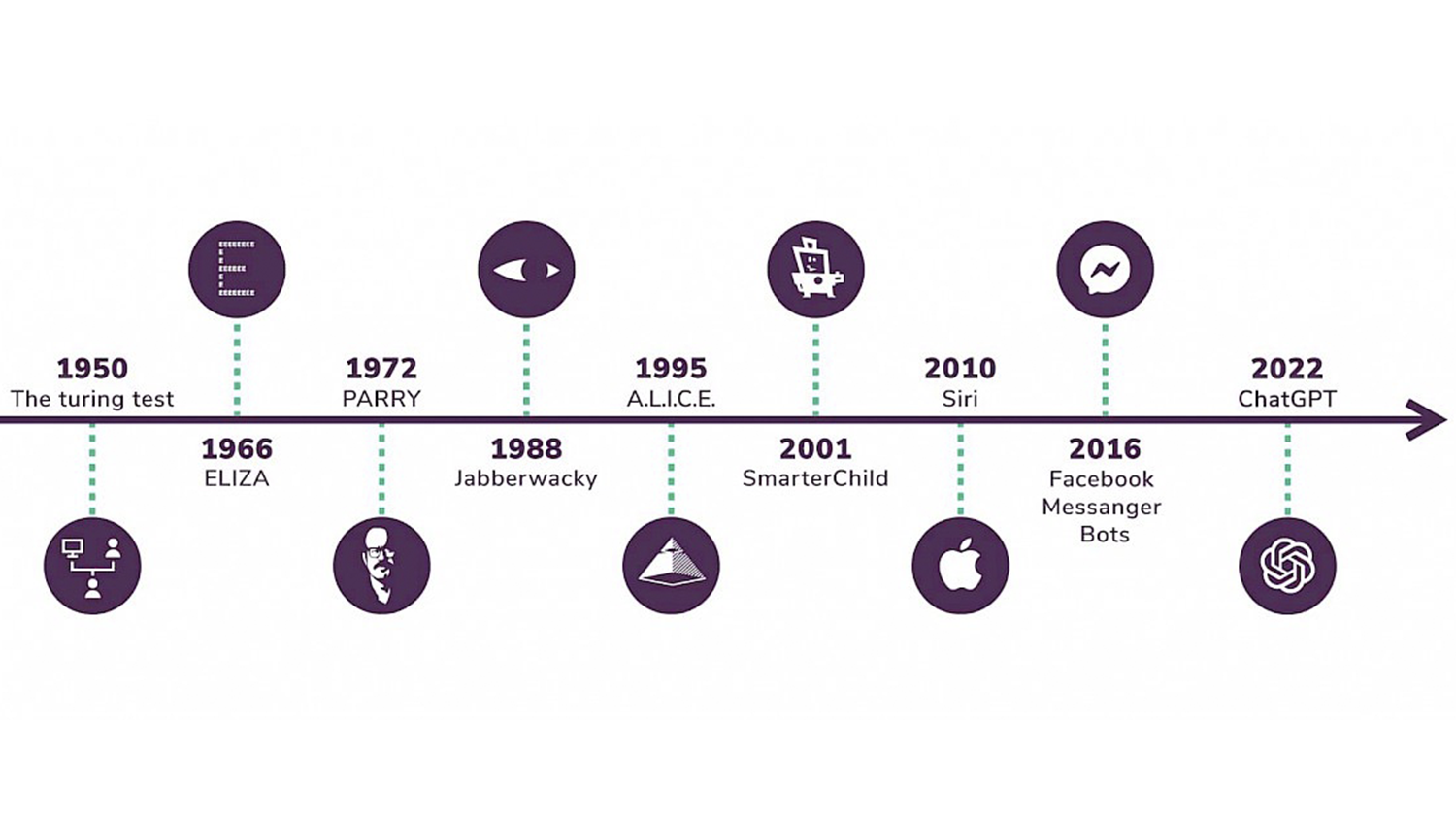Chatbots are becoming the centre point of innovation in customer service and marketing. They automate routine processes and open new horizons for personalised customer interactions, deepening relationships and creating valuable customer experiences. Recognising the full potential of chatbots and implementing them can be the critical factor that separates successful companies from the rest in the battle for attention. In this article, we’ll dive into the world of possibilities that come with the arrival of chatbots and explore how the proper application of this technology can be the key to sustainable growth and customer loyalty.
From simple scripts to marketing might: the evolution of chatbots
The history of chatbots dates back to the 1960s when the prototype chatbot called ELIZA was created. This primitive bot could simulate communication, but its responses were pre-set, and it could not learn from user interaction. However, ELIZA started the era of artificial intelligence and machine learning in chatbot development.

Over time, chatbots have evolved with the advancement of technology and the increasing availability of the internet. They have moved from simple text responses to more complex, dynamic and interactive forms of communication. Modern chatbots engage users in dialogue, offer promotions, discounts and new products, and participate in building long-term relationships with customers. They help companies stay in touch with customers 24/7, providing instant responses and improving overall brand engagement.
Successful and unsuccessful chatbot implementations
In the fast-paced world of digital technology, chatbots show significant potential in improving customer interactions.
The examples of Duolingo and Sephora illustrate how chatbots can effectively improve customer experience. Duolingo is a language learning platform that uses a chatbot to engage users in conversation in the language they are learning, thus providing a practical application of their new language skills.

(promotional material from Duolingo)
The cosmetics company Sephora uses a chatbot to offer personalised beauty tips and product recommendations based on user feedback and preferences.

On the other hand, the example of Microsoft’s Tay chatbot reveals the challenges developers can face. Tay was designed to learn from user interactions on Twitter but learned foul language.

So, by studying successful and unsuccessful chatbot examples, you can find ways to improve your chatbot, making it more effective and valuable for users and businesses.
Key strategies of chatbots
Let’s look at key strategies that will help you make your chatbot more productive and professional:
1. Understanding business goals:
- Identify the main goals you want to achieve with your chatbot: customer service, sales, getting feedback, etc.
- Analyse the needs of your target audience and how a chatbot can meet them.
2. Develop a clear dialogue plan:
- Make dialogue scripts that cover the most frequently asked questions and typical customer interaction scenarios.
- Provide for the possibility of switching to a live operator in complex or non-standard situations.
3. Testing and debugging:
- Test your chatbot regularly to identify and eliminate potential bugs and “awkward moments”.
- Collect user feedback and analyse it to improve the functionality and usability of the chatbot.
4. Ensure data security:
- Guarantee protection of user’s data with the help of modern encryption technologies.
5. Continuous updating and support:
- Provide continuous updates to the chatbot knowledge base and technical support to ensure high customer service.
Artificial intelligence and chatbots: a duo for the success of your business
Artificial intelligence dramatically enhances the efficiency of chatbots by enriching customer interactions. This technology allows chatbots to analyse user queries and improve their response algorithms. The personalised approach enhances the user experience, while extensive data analysis conducted by artificial intelligence provides valuable insights to optimise marketing strategies. Thus, integrating artificial intelligence into chatbots becomes a strategic move to improve customer interactions and marketing processes.

Improving marketing and customer interaction through chatbots
Chatbots play a crucial role in modern marketing and customer service, offering a range of benefits that make brand interactions with customers more effective and personalised. Let’s break down exactly how chatbots can improve your marketing strategies and customer service:
- Automation of Communication: Chatbots speed up responses to customer queries by providing instant information.
- Service Personalisation: Through customer data analysis, chatbots offer personalised product and service recommendations.
- Data Collection and Analysis: Chatbots help collect valuable data to analyse customer behaviour and optimise marketing strategies.
- Multi-Channel Marketing Support: Integrating chatbots across different marketing channels ensures a consistent customer experience across all platforms.
- Improved Campaign Performance: Chatbots automate feedback collection and monitor the effectiveness of marketing campaigns.
- Save Resources: Handling routine customer queries with chatbots allows staff to focus on more complex tasks.
Final thoughts
Chatbots significantly contribute to modern marketing and customer service, offering a range of benefits that make brand interactions more efficient and personalised. From automating communication to supporting multi-channel marketing, chatbots are becoming powerful tools to improve your marketing strategies and customer service.
With chatbots and artificial intelligence on your side, the possibilities for improving your customer interactions and marketing processes are endless. It’s time to take advantage of these innovative solutions to reach new heights in your business.
